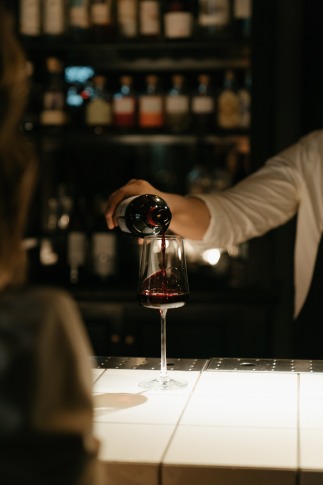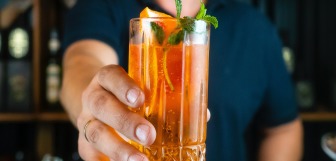How to Upsell as a Bartender
As a bartender, one of your main goals is to upsell drinks and increase profits for the bar. But while upselling may be part of the job description, and very profitable if done correctly, it can be a notoriously difficult task. But don't be shaken or stirred - if you're wondering how to upsell drinks in a bar, we've got the techniques on tap.
What is upselling in a bar?
In bartending terms, upselling is a sales technique that involves pushing premium or upgraded drinks to customers, in a bid to get them spending more on alcohol.
While the use of upselling techniques in bars isn’t always widely discussed, this process is the best way to drive poor profits, bar none. Not only does upselling help to increase sales, but it also helps improve the quality of the drinks you’re serving overall, which can work wonders for your bar's reputation and revenue respectively.
Don't overdo it
While you might be serving bottles of rum, don't go overboard. The last thing you want to do is come across as pushy, or worse, like you're trying to take advantage of someone who's had one too many. Be subtle in your selling, and let the customer make the final decision.
You also want to ensure that the descriptive language you're using represents how you really feel about the drink. Don't let your listing spill over into a lecture of white lies.
Learn exactly what it is that you're offering and describe the product in a way that represents what you actually think. That way, when you give your advice, it's genuine.
 Squeeze cash from cocktails
Squeeze cash from cocktails
Cocktails are one of the most profitable refreshments you can pour, and by upselling these dramatic drinks you can boost your bottom line.
As with all alcoholic beverages, when it comes to cocktails, the most popular profit-pushing practice is upgrading the kind of alcohol being used.
If that isn't what the customer's leaning towards, you also have the option to propose a completely different drink that's centred around the same liquor. It's important to note that after being opened, liquor can go stale, so upselling whenever possible and using the whole of a top-shelf bottle are crucial if you want to keep earnings afloat.
Suggestive selling
Suggesting something a little more pricey than what the client was originally planning to purchase is also an effective technique of sales pushing at your bar. If you appear convincing and confident in your idea, they'll be more inclined to accept it. Considering the secondary additional sale is usually significantly smaller than the original acquisition, the customer won't be concerned by the extra money being spent. For example:
A customer having work drinks comes to the bar with a colleague and asks for five pints. You note their table consists of guys having a good time. Whilst pouring for the table, you mention the current deal the bar has when you buy two shots.
There are three ways this scenario can pan out:
- They decline – but they now know about the shots, which will undoubtedly reappear in later conversation.
- They accept the offer and secondary sale, and do the shots at the bar
- The deal appeals to them so much that they order a tray of shots for the table.
With this technique, no matter the outcome, the opportunity to upsell and maximise your margins is always made.
 Extra, extra read all about it
Extra, extra read all about it
Another technique used by bartenders to upsell is offering 'extra'. Whether it's an upgraded brand or an added cocktail garnish, this is a tried and true method to get customers spending more.
For instance, if someone orders a gin and tonic, you could upsell them by offering them a top-shelf gin instead of the house brand. If they're not interested in that, you could try adding a garnish, like fruit. Something small that won't cost you much, but will make the drink far more appealing.
You also shouldn't be afraid of freebies and special offers, since a sample pour can increase the profitability of a spirit by 2000% [1]. If someone orders a vodka soda, you could upsell them by offering to add a splash of cranberry juice or lime cordial at no extra cost.
This makes the drink more enjoyable and will likely convince the customer to order it again in the future for the regular price.
You also have the option of introducing a concept called the break-even bottle. This is usually a very expensive one, that’s sold by the shot at the bar’s cost price, without any markup. While this doesn’t seem like the most obvious upselling strategy, it actually works to get customers trying (and liking) high-end spirits, which they might not order otherwise, and encourages them to buy drinks made with these premium spirits in the future.
Trust the process
Instead of pressuring your patrons for a quick sale, taking the time to build trust and rapport with your customers will do wonders for your upselling game.
When it comes to upselling, it's not about being forceful or insincere - it's about providing value and offering suggestions that will genuinely improve the customer's experience.
If you focus on providing great service, and high-quality bartender customer conversation, everything else will fall into place. Establishing a trusting professional relationship with your patrons is really the key to successful upselling, and is something that takes time to develop.
Once you do solidify this though, you won't need to work hard for your customers to trust your suggestions. Being made to feel like you're offering accurate and informed advice helps the customer completely come away from the fact that you're trying to persuade them to spend more money.
 Drink in the details
Drink in the details
It's time to polish your glasses and not ones above the bar. Studying the alcohol that your bar offers, and educating your customers, is crucial to your upselling strategy.
This rings especially true when talking about wine. Providing small relevant and engaging facts about the wineries, grapes, and tasting notes for each variety contextualises the selection and gives each bottle of wine meaning.
This in turn makes customers more invested and inclined to purchase, and in fact, can be applied to any specialist alcohol you're trying to sell.
With both wine and beer, providing context in terms of pairing can also offer your customers much food for thought. If you work in a bar and restaurant, if someone approaches the bar on the way back to their table, for instance, ask about their dish.
You should have a list of medium to high-end wine (or beer) varieties that go well with each menu item, compiled and memorised. This way you can offer a pairing confidently on the fly, and start selling wine like a pro.
Fill up your cup with an award-winning EPOS system
Running a bar doesn't have to be difficult. Epos Now offers state-of-the-art POS systems for hospitality businesses, which let you manage your business with ease and optimal efficiency.
Our systems let you choose the tools and insights to help your business achieve its goals. Designed to work as a complete business management system, you can control all vital aspects of your company from one cloud-based system.
Receive detailed analysis on the areas that matter to your business:
- Review profitability reports based on individual product performance, trending items, best and worst sellers, and employee sales
- View sales analyses on profit margin, cash flow, and other expenses
- Review reports on peak times for better staff scheduling and floorplan management
- Access multi-award-winning inventory management systems that sync online sales and in-person sales for the most up-to-date stock levels
- Automate stock purchasing so you never miss a sales opportunity
- Integrate with the business automation apps that are right for your business
- Table management and booking system integrations available for an optimised service
If you're sold on our upselling strategies and want to learn more, we'd love to hear from you!
